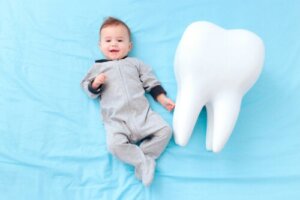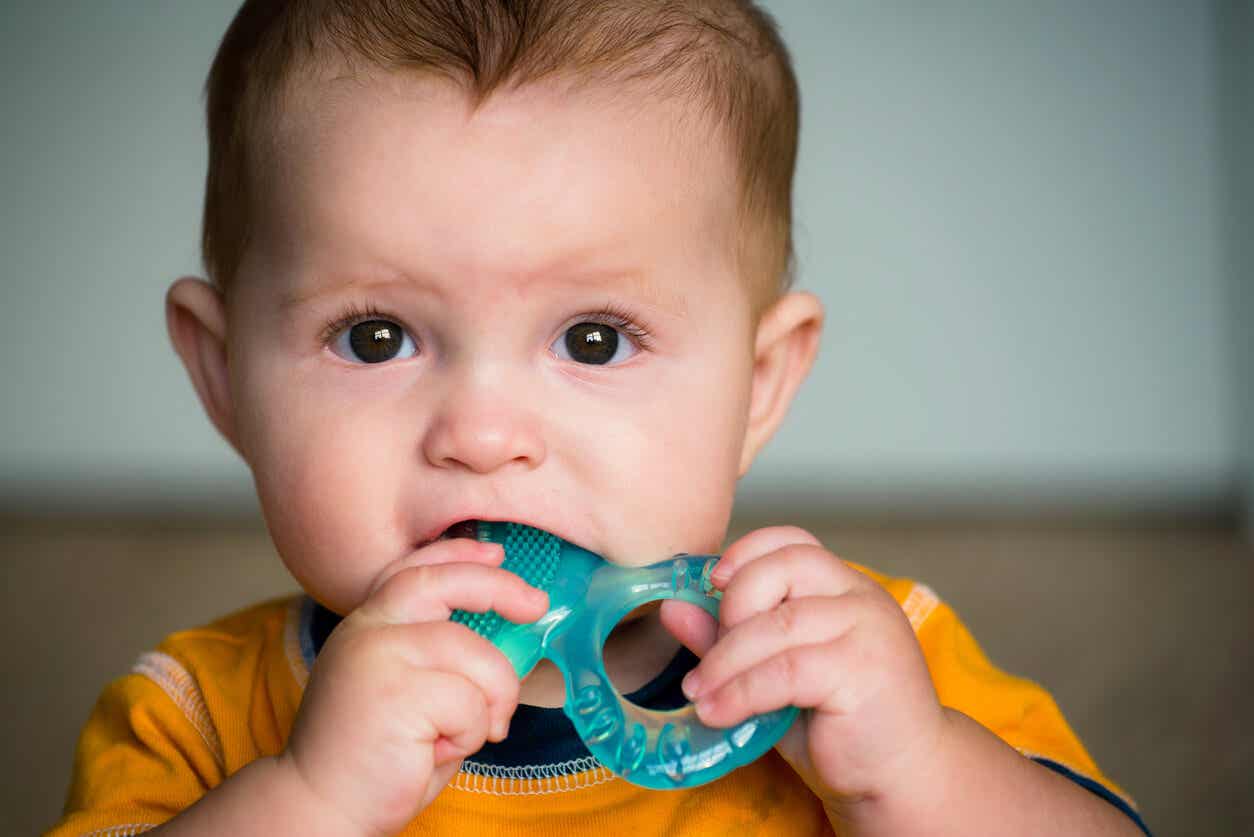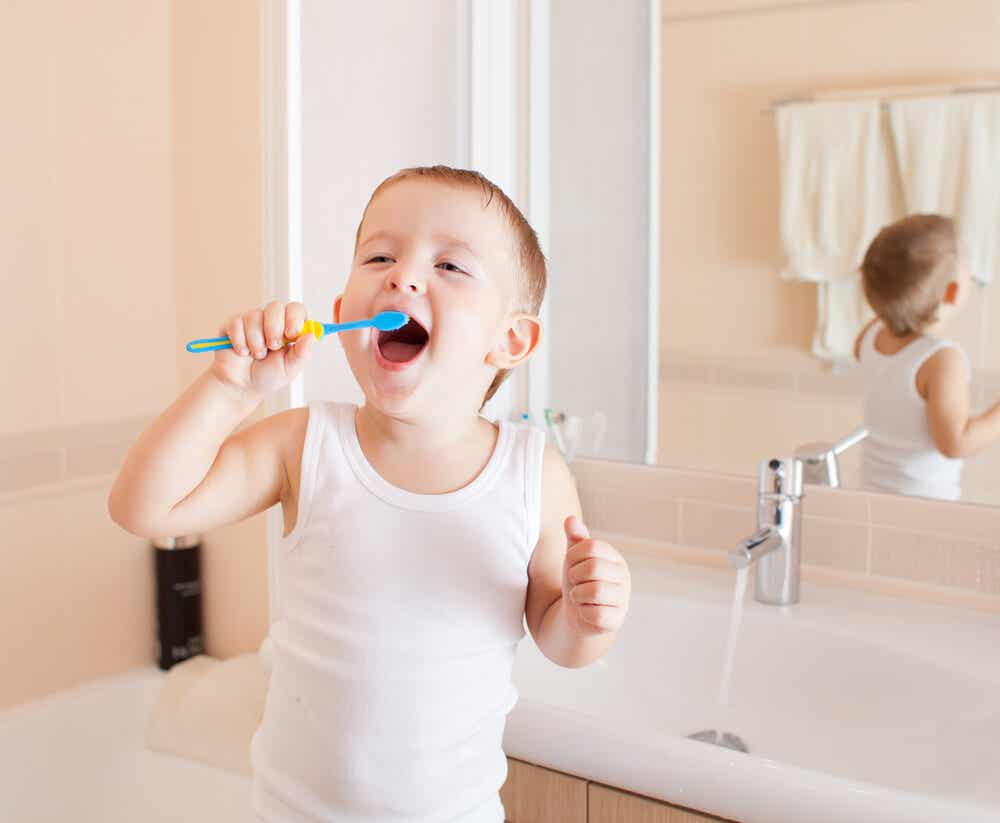Fun Facts About Baby Teeth

In this article, we’ll share several fun facts about baby teeth that are worth taking into account. Because in order to take proper care of your little one’s mouth, it’s important to know about the structures that make it up.
In the following article, you’ll find out when the temporary teeth are formed, how many there are, and what they’re used for. Also, we’ll tell you how to take care of them in order to maintain children’s oral health.
Baby teeth begin to form in the mother’s womb
A child’s teeth begin to form when the baby is developing in the mother’s womb. The process begins between the sixth and eighth weeks of gestation and continues throughout the pregnancy.
At the moment of birth, the transitional or baby teeth are already lodged inside the jaws, where they will remain until the moment of eruption. When babies come out of the womb, the teeth aren’t visible in the mouth, but they’re there, hidden under the gums.
This is one of the fun facts about baby teeth that’s important to know. By knowing that the teeth are being formed during pregnancy, we can give them the attention they need from the beginning.
How? Through proper nutrition during pregnancy. Eating a varied and balanced diet, with sufficient calcium, phosphorus, vitamins, and proteins, helps to ensure the availability of nutrients for the mineralization of the teeth that are forming.
Eruption of baby teeth

Baby teeth begin to erupt around the time babies reach 6 to 8 months of age. In reality, this age is an estimate, as each child has their own growth rate and, in some little ones, teeth appear earlier and, in others, they take longer. The process usually ends around 3 years of age.
For the tooth to appear in the mouth, its crown must break through the gum and make its way into the oral cavity. This is an uncomfortable time for some children and it’s common for them to feel irritable and nervous.
Other symptoms, such as excessive drooling, the need to put everything in their mouths, sudden crying, and sleeping problems can appear during this stage. It’s a challenge for adults to accompany their little ones during this process with lots of love and patience.
20 dental pieces
Also on our list of fun facts about baby teeth is the number of teeth they have. And the fact is that the number of temporary and permanent teeth isn’t the same; babies have 20 baby teeth, but they end up having 32 permanent teeth.
The 20 baby teeth are located in both jaws: 10 in the upper jaw and 10 in the lower jaw. In each arch, there are 5 dental pieces to the right and 5 to the left of the midline. There are 8 incisors–4 central and 4 lateral–4 canines, and 8 molars.
What do baby teeth look like?
The appearance of temporary teeth is also one of the fun facts about baby teeth. Their color is much whiter and their size is smaller compared to that of permanent teeth.
- The teeth have a visible portion that’s in the oral cavity, called the crown, and another part that’s located inside the bone, covered by the gum, which is the root. The purpose of the root is to hold the teeth in place.
- The external structure that covers the crown of the dental elements is the enamel, which is a hard tissue that protects them.
- Inside is the dentin, the most extensive layer, with a hardness similar to that of bone.
- The innermost portion is the pulp, where the nerve endings and blood vessels are located.
These last two tissues are found in both the crown and the root.
What are baby teeth used for?
Although many adults believe otherwise, baby teeth are very important for children.
They’re essential for chewing, eating, and speaking, as they’re involved in the pronunciation of various phonemes. They also have a social and esthetic role, as children express themselves and relate to others through smiles.
At the same time, a very valuable function they have is to hold the space for the definitive teeth that are developing inside the jaws. Therefore, when they erupt, the baby teeth act as guides that allow for proper positioning of the permanent teeth.
When do they fall out?
As with eruption, the moment when the baby teeth fall out to be replaced by the permanent teeth depends on each child. In general, the process begins between 5 and 6 years of age and ends around 12-13 years of age. This is accompanied by the growth of the jaws.
The permanent teeth reabsorb the roots of the baby teeth, which begin to move until they fall out. Then, the permanent tooth appears in the mouth to replace the one that has come out. During this period, both types of teeth coexist in the mouth, which is why it’s known as mixed dentition.
The need to take care of baby teeth

Now that you know these fun facts about baby teeth, you’ll understand the importance of keeping these teeth healthy. They play a very important role in the life of our little ones.
Caring for a child’s dental elements should begin at conception, with proper nutrition of the mother during gestation and proper obstetric controls. When the baby’s born, it’s time for adults to continue taking care of the health of the oral cavity.
Mouth hygiene should begin even before the teeth appear, by cleaning the gums with a clean, wet gauze. Then, when the teeth appear, it’s important to start brushing them.
Adults should take care of their children’s dental hygiene until they’re able to do it by themselves, which happens after the age of 6, approximately. Then, they’ll have to supervise them and accompany them in the habit.
From the time teeth appear, it’s important to take care of proper dental hygiene, using a toothbrush and the amount of toothpaste according to their age, and complementing it with the use of dental floss. In addition, it’s essential that children eat a nutritious diet and avoid foods with high sugar content.
Regular visits to the pediatric dentist from the first year of life help to avoid many problems in the mouth.
The control of jaw growth and tooth eruption, detecting the presence of harmful habits, and early diagnosis of oral diseases allows us to address any condition in time. This avoids complications and more difficult or complicated treatments.
That is why adults should take care of their children’s oral health. This will allow little ones to smile with peace of mind during their childhood.
In this article, we’ll share several fun facts about baby teeth that are worth taking into account. Because in order to take proper care of your little one’s mouth, it’s important to know about the structures that make it up.
In the following article, you’ll find out when the temporary teeth are formed, how many there are, and what they’re used for. Also, we’ll tell you how to take care of them in order to maintain children’s oral health.
Baby teeth begin to form in the mother’s womb
A child’s teeth begin to form when the baby is developing in the mother’s womb. The process begins between the sixth and eighth weeks of gestation and continues throughout the pregnancy.
At the moment of birth, the transitional or baby teeth are already lodged inside the jaws, where they will remain until the moment of eruption. When babies come out of the womb, the teeth aren’t visible in the mouth, but they’re there, hidden under the gums.
This is one of the fun facts about baby teeth that’s important to know. By knowing that the teeth are being formed during pregnancy, we can give them the attention they need from the beginning.
How? Through proper nutrition during pregnancy. Eating a varied and balanced diet, with sufficient calcium, phosphorus, vitamins, and proteins, helps to ensure the availability of nutrients for the mineralization of the teeth that are forming.
Eruption of baby teeth

Baby teeth begin to erupt around the time babies reach 6 to 8 months of age. In reality, this age is an estimate, as each child has their own growth rate and, in some little ones, teeth appear earlier and, in others, they take longer. The process usually ends around 3 years of age.
For the tooth to appear in the mouth, its crown must break through the gum and make its way into the oral cavity. This is an uncomfortable time for some children and it’s common for them to feel irritable and nervous.
Other symptoms, such as excessive drooling, the need to put everything in their mouths, sudden crying, and sleeping problems can appear during this stage. It’s a challenge for adults to accompany their little ones during this process with lots of love and patience.
20 dental pieces
Also on our list of fun facts about baby teeth is the number of teeth they have. And the fact is that the number of temporary and permanent teeth isn’t the same; babies have 20 baby teeth, but they end up having 32 permanent teeth.
The 20 baby teeth are located in both jaws: 10 in the upper jaw and 10 in the lower jaw. In each arch, there are 5 dental pieces to the right and 5 to the left of the midline. There are 8 incisors–4 central and 4 lateral–4 canines, and 8 molars.
What do baby teeth look like?
The appearance of temporary teeth is also one of the fun facts about baby teeth. Their color is much whiter and their size is smaller compared to that of permanent teeth.
- The teeth have a visible portion that’s in the oral cavity, called the crown, and another part that’s located inside the bone, covered by the gum, which is the root. The purpose of the root is to hold the teeth in place.
- The external structure that covers the crown of the dental elements is the enamel, which is a hard tissue that protects them.
- Inside is the dentin, the most extensive layer, with a hardness similar to that of bone.
- The innermost portion is the pulp, where the nerve endings and blood vessels are located.
These last two tissues are found in both the crown and the root.
What are baby teeth used for?
Although many adults believe otherwise, baby teeth are very important for children.
They’re essential for chewing, eating, and speaking, as they’re involved in the pronunciation of various phonemes. They also have a social and esthetic role, as children express themselves and relate to others through smiles.
At the same time, a very valuable function they have is to hold the space for the definitive teeth that are developing inside the jaws. Therefore, when they erupt, the baby teeth act as guides that allow for proper positioning of the permanent teeth.
When do they fall out?
As with eruption, the moment when the baby teeth fall out to be replaced by the permanent teeth depends on each child. In general, the process begins between 5 and 6 years of age and ends around 12-13 years of age. This is accompanied by the growth of the jaws.
The permanent teeth reabsorb the roots of the baby teeth, which begin to move until they fall out. Then, the permanent tooth appears in the mouth to replace the one that has come out. During this period, both types of teeth coexist in the mouth, which is why it’s known as mixed dentition.
The need to take care of baby teeth

Now that you know these fun facts about baby teeth, you’ll understand the importance of keeping these teeth healthy. They play a very important role in the life of our little ones.
Caring for a child’s dental elements should begin at conception, with proper nutrition of the mother during gestation and proper obstetric controls. When the baby’s born, it’s time for adults to continue taking care of the health of the oral cavity.
Mouth hygiene should begin even before the teeth appear, by cleaning the gums with a clean, wet gauze. Then, when the teeth appear, it’s important to start brushing them.
Adults should take care of their children’s dental hygiene until they’re able to do it by themselves, which happens after the age of 6, approximately. Then, they’ll have to supervise them and accompany them in the habit.
From the time teeth appear, it’s important to take care of proper dental hygiene, using a toothbrush and the amount of toothpaste according to their age, and complementing it with the use of dental floss. In addition, it’s essential that children eat a nutritious diet and avoid foods with high sugar content.
Regular visits to the pediatric dentist from the first year of life help to avoid many problems in the mouth.
The control of jaw growth and tooth eruption, detecting the presence of harmful habits, and early diagnosis of oral diseases allows us to address any condition in time. This avoids complications and more difficult or complicated treatments.
That is why adults should take care of their children’s oral health. This will allow little ones to smile with peace of mind during their childhood.
All cited sources were thoroughly reviewed by our team to ensure their quality, reliability, currency, and validity. The bibliography of this article was considered reliable and of academic or scientific accuracy.
- Pillaca Maricella, Medina (2017) Desarrollo de la dentición fase intrauterina, erupción evolución de las denticiones temporales y permanentes.
- Salazar Fernández, Cinthia Pamela. (2020) Crecimiento craneofacial y desarrollo de las arcadas dentarias.
- Olivera del Río, Juan. Manual de Anatomía dental y pulpar de dientes primarios. Ediciones Uleam. Ecuador. Año 2018.
- Vila, Rafael Esponda. Anatomía dental. UNAM, Dirección General de Publicaciones y Fomento Editorial, 2020.
- Cubas, César Díez. Anatomía Dental para higienistas de atención primaria. Vision Libros, 2005.
- Ruiz Intriago, Bélgica Johana. Importancia de la preservación de dientes temporarios en niños. BS thesis. Universidad de Guayaquil. Facultad Piloto de Odontología, 2020.
- Aimituma Tairo, Katiuscia. (2019) Desarrollo y erupción dentaria.
- Ayala Pérez, Yolanda, Leyanis de la Caridad Carralero Zaldívar, and Beatriz del Rosario Leyva Ayala. La erupción dentaria y sus factores influyentes. Correo Científico Médico 22.4 (2018): 681-694.
- Pentón, Armando San Miguel, Olga Lidia Véliz Concepción, and Raiza Zenaida Escudero Alemán. Erupción dentaria,¿ está todo dicho?. Acta Médica del Centro 11.1 (2017): 72-75.
- de la Teja Ángeles, Eduardo. Erupción dentaria. (2019).
- Yange Flores, Kelvin Enrique. Estado nutricional y erupción dentaria. BS thesis. Universidad de Guayaquil. Facultad Piloto de Odontología, 2020.
This text is provided for informational purposes only and does not replace consultation with a professional. If in doubt, consult your specialist.








